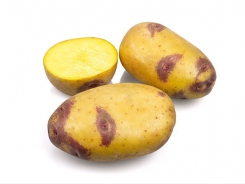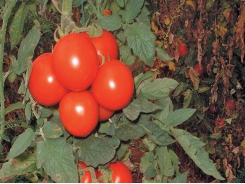How tomato growers can practice IPM

When it comes to Integrated Pest Management (IPM), tomatoes have quite a complex array of requirements which will depend on the varieties planted and the region where they are grown, as some diseases and pests only occur in certain areas.
The green peach aphid, however, is found everywhere. As their numbers increase, they can damage the plant. What’s more, they also transmit tobacco mosaic virus (TMV). This disease is easily spread by handling the plants. I’ve often found ladybirds eliminate this pest completely. If there aren’t enough to control the aphid population, Pirimicarb can be used, even if only on a spot spray basis. This insecticide has little effect on ladybirds.
Whiteflies
Whiteflies, meanwhile, are found in most areas, but are a greater threat in regions where tomato curly stunt virus occurs. Whiteflies are the vector and where this disease occurs, zero tolerance should be shown, and IPM isn’t an option. When moving through your crop, you’ll see the adult whiteflies fly from the foliage when you brush against it. They often look like a blur and hence are also known as ‘ghost flies’.
Their larvae secrete honeydew, which then turns black when a fungus develops on it. If you see this, investigate, as it could be whitefly – or, indeed, aphids. Whiteflies attack many species of commercial crops and weeds, and the reason it’s not a bigger pest is that there are natural enemies keeping the balance.
As with any biological control agent, they’re sometimes able to build up to the point where they eliminate the pest they’re feeding on, and die out. The pest may then return. With populations of its main natural enemy at a low ebb, the whitefly can cause a lot of damage if not controlled.
Parasitoid
On the other hand, the pest and natural enemy may enter the land together and control may be imminent, provided you don’t apply pesticides that will kill off the biological control agent. The insect which has the biggest impact on whiteflies is the parasitoid wasp Encarsia formosa.
It’s between 0,6mm and 0,7mm long and black with a yellow abdomen. The adult wasp lays a single egg in a whitefly pupa. After about 10 days, the pupa turns black or brown, and hatches about 10 days after this. The wasp can lay up to 200 eggs and destroys even more whiteflies by feeding on them. The adults pierce the pupae or advanced larvae with their ovipositors and drink the body fluids. The wasps are thus a very effective means of controlling whitefly when they occur at the beginning of an outbreak.
Whitefly larvae can be found on the underside of leaves (usually older ones).They’ll initially appear as green dots and you need to check if any become a dark colour, because this is a sign that Encarsia are active. Because of their size, the wasps themselves are more difficult to spot.
The amount of dark pupae compared with the severity of the infestation and damage should enable you to determine whether to allow the wasps to clean up the infestation, or whether chemical control will be necessary. I usually wait a couple of weeks and monitor the progress of the parasitoids before making a decision. Encarsia has been used for at least 100 years to control whitefly, especially in tunnels, where they’ll also ‘protect’ cucumbers.
Market
The Dutch company, Koppert, which is known for supplying insects to control crop pests in Europe, has now opened a branch in South Africa. It has been active in Kenya for a while and, with tightening regulations on crop chemicals and the growth of the organic sector, now believes there’s a market for its products in SA.
Có thể bạn quan tâm
Phần mềm

Phối trộn thức ăn chăn nuôi

Pha dung dịch thủy canh

Định mức cho tôm ăn

Phối trộn phân bón NPK

Xác định tỷ lệ tôm sống

Chuyển đổi đơn vị phân bón

Xác định công suất sục khí

Chuyển đổi đơn vị tôm

Tính diện tích nhà kính

Tính thể tích ao hồ



 6 Ways to Build Your Own Tomato Cages
6 Ways to Build Your Own Tomato Cages  More common potato diseases
More common potato diseases